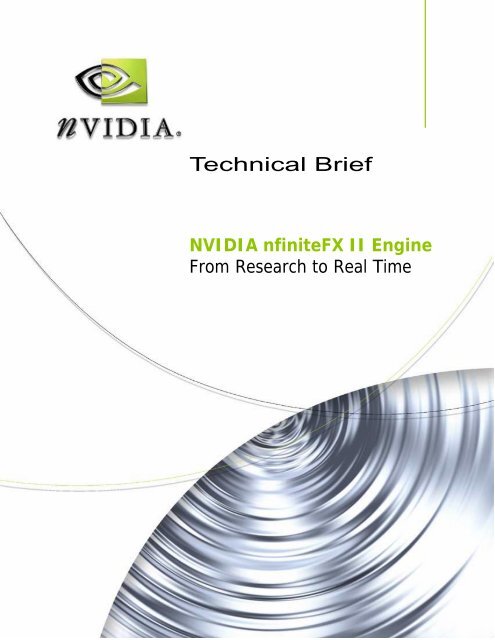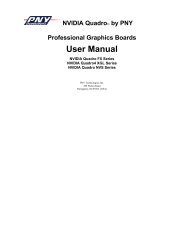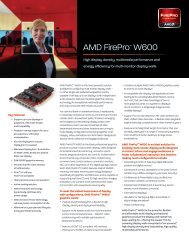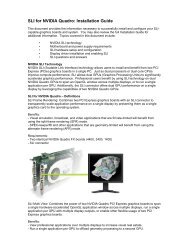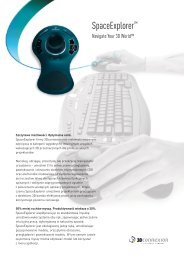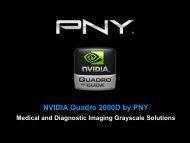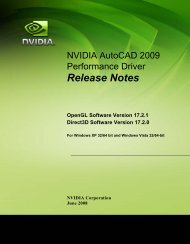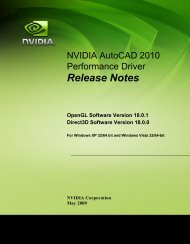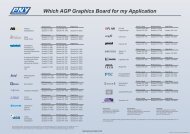NVIDIA nfiniteFX II Engine - Servodata
NVIDIA nfiniteFX II Engine - Servodata
NVIDIA nfiniteFX II Engine - Servodata
You also want an ePaper? Increase the reach of your titles
YUMPU automatically turns print PDFs into web optimized ePapers that Google loves.
Technical Brief<br />
<strong>NVIDIA</strong> <strong>nfiniteFX</strong> <strong>II</strong> <strong>Engine</strong><br />
From Research to Real Time
<strong>NVIDIA</strong> <strong>nfiniteFX</strong> <strong>II</strong> <strong>Engine</strong><br />
Research and the<br />
Need for Processing Power<br />
Computer graphics research has always pushed the boundaries of software and<br />
hardware, forcing us to ask the question: “If the technology were fast enough, what<br />
else could be done?”<br />
Thankfully, as hardware and software technologies advance, some of these<br />
questions can now be answered. The GeForce4 family of Graphics Processing Units<br />
(GPUs) with dedicated high-speed memory pipelines are capable of calculating<br />
billions of operations per second, and enable the development of unbelievably<br />
complex effects through their powerful shading instruction sets. Through the use of<br />
their integrated dual vertex and advanced pixel shaders, the GeForce4 GPUs have<br />
unleashed ferocious graphics power on many of the computer graphics research<br />
topics currently being studied.<br />
A great example of the power behind the GeForce4 GPUs are their inherent ability<br />
to solve one of the classic computer graphics problems of all time: how to render<br />
realistic hair and fur. Animals that have skin textures have traditionally been easier<br />
to render than fur. For example, the dinosaurs in Jurassic Park were easier to make<br />
lifelike and believable than the animals in the safari movie Jumanji. Trying to render<br />
hair and fur in real time has historically resulted in animals that looked plastic, stiff,<br />
and constrained. Computer-generated hair and fur should give the appearance of<br />
texture and movement, and it should show off the subtle reflections and light<br />
absorption that real hair or fur would in a given situation.<br />
For the first time ever, and only through the power of <strong>NVIDIA</strong>’s <strong>nfiniteFX</strong> <strong>II</strong><br />
engine, which includes support for dual vertex shaders, advanced pixel shader<br />
pipelines, 3D textures, shadow buffers and z-correct bump mapping, is it now<br />
possible to render, among other things, incredibly complex, high quality hair and fur<br />
while delivering very fast frame rates.<br />
NV Doc # - TB-00313-001 1<br />
1/16/2002
<strong>NVIDIA</strong> <strong>nfiniteFX</strong> <strong>II</strong> <strong>Engine</strong><br />
A Little Bit of History<br />
California Institute of Technology’s Fuzzy Bear<br />
In the early days of research, scientists at the<br />
California Institute of Technology created a new<br />
approach for rendering hair and fur by using a 3D<br />
hair texture volume. This 3D texture would have a<br />
surface frame, and normal tangent and binormal 3D<br />
vectors, used to calculate lighting and reflections. The<br />
parameters of the lighting model would be freely<br />
distributed throughout the volume. This volume was<br />
then rendered in software by walking through the<br />
volume and accumulating the densities along the<br />
viewing vector (a ray-casting approach).<br />
Figure 1. Fuzzy Bear<br />
This approach produced the “Fuzzy Bear” picture, which became a reference of<br />
sorts in the computer graphics industry (see Figure 1). One of the interesting facts<br />
to realize is that when this research occurred in 1989, a single frame took over two<br />
hours to render, running on a network of large IBM mainframes, containing 12<br />
3090 processors and four 3081 processors. And, while the bear was a graphics<br />
breakthrough for its time, the rendering time of two hours per frame was not<br />
acceptable for any real-time applications.<br />
Princeton and Microsoft’s Furry Bunny<br />
In early 2001, researchers at Princeton University<br />
and Microsoft Corporation published a paper on the<br />
subject of real time fur. The principal contribution of<br />
this paper was the concept of rendering the 3D fur<br />
volume by generating a series of concentric “shells”.<br />
These shells were created by scaling the base “skin”<br />
layer along the vertex normal. The textures for these<br />
shells would be created from samples of the 3D hair<br />
texture at different depths in the volume. These<br />
textures would then be applied to their<br />
corresponding concentric shell layers, and the<br />
concentric shells would then be blended together to<br />
produce the final appearance of hair or fur.<br />
Figure 2: Furry Bunny<br />
Lastly, in addition to the shell geometry, the researchers added the use of specially<br />
created fin geometry and textures to help enhance the object if viewed in silhouette.<br />
These fin textures are used to produce the wispy bits of hair and fur that add realism<br />
to the animal, especially when viewed in silhouette.<br />
NV Doc # - TB-00313-001 2<br />
1/16/2002
<strong>NVIDIA</strong> <strong>nfiniteFX</strong> <strong>II</strong> <strong>Engine</strong><br />
The result of their research became known as “Furry Bunny” (see Figure 2). This<br />
furry bunny, which pushed the technological envelope about a year ago, was<br />
rendered on a <strong>NVIDIA</strong> GeForce 256 Graphics Processing Unit (GPU).<br />
The furry bunny contained 5,000 faces (or Polygons), 7,547 edges, 306 patches and<br />
ran between 12 and 23 frames per second (depending on the number of concentric<br />
shells that were turned on).<br />
One of the most interesting parts of this research paper was the rendering<br />
discussion and future work sections. In these sections, the researchers discussed the<br />
current state of hair and fur rendering as well as directions of where the technology<br />
was going. The researchers specifically mentioned two key technologies:<br />
Programmable vertex shaders. Within the coming year, commodity graphics<br />
hardware will have programmable vertex shaders. Such shaders will be ideal for<br />
accelerating shell rendering, since they can directly evaluate the geometric offsets<br />
between shells, in fact using only two additional shader instructions.<br />
Programmable pixel shaders. Future programmable pixel shaders may be able to<br />
perform per-pixel lighting, which would be useful for wavy and curly hair patterns.<br />
NV Doc # - TB-00313-001 3<br />
1/16/2002
<strong>NVIDIA</strong> <strong>nfiniteFX</strong> <strong>II</strong> <strong>Engine</strong><br />
The Future Is Here Now<br />
<strong>NVIDIA</strong>’s Wolfman<br />
The <strong>NVIDIA</strong> GeForce4 GPU family and <strong>nfiniteFX</strong> <strong>II</strong> engine represents the first<br />
time that realistic fur with per-pixel lighting can be applied to a highly complex<br />
animated character and run at high frame rates.<br />
The <strong>nfiniteFX</strong> <strong>II</strong> engine’s dual vertex shaders are able drive more than 100 million<br />
vertices per second. This power is needed as the Wolfman contains over 100,000<br />
polygons, or more than 20 times the complexity of the “Furry Bunny” research<br />
project of a short year ago. Figure 3 below contains a wire mesh of the Wolfman<br />
before the concentric shells have been applied; the inset version is fully rendered.<br />
! Without concentric shells<br />
and fully-rendered<br />
Figure 3. Wireframe Model of <strong>NVIDIA</strong>’s Wolfman<br />
NV Doc # - TB-00313-001 4<br />
1/16/2002
<strong>NVIDIA</strong> <strong>nfiniteFX</strong> <strong>II</strong> <strong>Engine</strong><br />
The Wolfman uses eight concentric fur shells that can be seen in Figure 4. The color<br />
and density of the fur is controlled using a separate texture map that covers the<br />
entire body, which gives the fur its distinct look, rather than a uniform pattern (see<br />
Figure 7). The <strong>nfiniteFX</strong> <strong>II</strong> engine’s advanced pixel shader support for 3 and 4<br />
textures accelerates this type of rendering.<br />
Figure 4. With Concentric Shells and Fins<br />
Notice the extra layers of geometry around the arm.<br />
This helps with the wispy hairs and improves the<br />
image when viewed in silhouette.<br />
NV Doc # - TB-00313-001 5<br />
1/16/2002
<strong>NVIDIA</strong> <strong>nfiniteFX</strong> <strong>II</strong> <strong>Engine</strong><br />
The Wolfman is not a mere static model. Rather, it is a completely skinned<br />
animation. This Wolfman contains a 61-bone skeleton (see Figure 6). The<br />
complexity of this model is on par with that used in television and film special<br />
effects production. Each and every vertex of the skin, fur layers, and fin geometry<br />
are deformed in real-time to match the movement of the underlying skeleton. The<br />
complexity of this task is amazing, as the <strong>nfiniteFX</strong> <strong>II</strong> engine needs to handle these<br />
vertex deformations for each of the eight layers.<br />
The Wolfman’s 61-Bone<br />
skeleton drives a skinned<br />
animation that affects each<br />
concentric shell layer of the<br />
model. Each vertex of every<br />
shell deforms every frame.<br />
The result is unbelievably<br />
realistic muscular movement<br />
as the Wolfman stalks the<br />
streets of London.<br />
Figure 6: The Wolfman’s Bone Skeleton<br />
One of the unique properties of stranded material such as hair and fur is that it<br />
reflects light more in some directions than others. This is known as “anisotropic”<br />
lighting, and is computationally expensive to reproduce.<br />
The <strong>nfiniteFX</strong> <strong>II</strong> engine has advanced pixel shaders that help the GeForce4 GPUs<br />
deliver 50% more performance than the GeForce3. These improvements allow the<br />
GPUs to deliver anisotropic lighting to the Wolfman while maintaining fast frame<br />
rates. Individual strands of hair and patches of fur react based on the position and<br />
the intensity of the light and the angle that the light strikes the fur. Figure 7 shows<br />
the fully rendered Wolfman.<br />
NV Doc # - TB-00313-001 6<br />
1/16/2002
<strong>NVIDIA</strong> <strong>nfiniteFX</strong> <strong>II</strong> <strong>Engine</strong><br />
Individual hairs react to the light based on orientation of the<br />
light and structure of hair. This occurs on a per-pixel basis.<br />
Figure 7. Rendered with Concentric Shells and Anisotropic Lighting<br />
Table 1 shows the content and performance of various fur projects:<br />
Table 1. Furry Creatures Comparison Chart<br />
Processor Polygons Frame Rate<br />
Fuzzy Bear IBM 3090/3080 NA 2 Hrs/Frame<br />
Fuzzy Bunny GeForce 32M 5,000 12-23 fps<br />
Furry Wolfman GeForce4 Ti 4600 100,000 + 60+ fps<br />
NV Doc # - TB-00313-001 7<br />
1/16/2002
<strong>NVIDIA</strong> <strong>nfiniteFX</strong> <strong>II</strong> <strong>Engine</strong><br />
Conclusion<br />
As hardware and software technologies evolve, so do the research and remedies. In<br />
the case of rendering hair and fur, the <strong>nfiniteFX</strong> <strong>II</strong> engine provides a vehicle to<br />
approach the latest research and display the results in real time. In addition, these<br />
renderings occur at very high frame rates with stunning antialiased visuals.<br />
With the <strong>nfiniteFX</strong> <strong>II</strong> engine, <strong>NVIDIA</strong> has once again raised the bar for high<br />
quality visuals, while simultaneously delivering ferocious graphics power. The<br />
<strong>nfiniteFX</strong> <strong>II</strong> engine’s dual vertex shaders are capable of driving the complex type of<br />
geometries required for a skinned character like the Wolfman (100k+ polygons); and<br />
its advanced pixel shaders deliver blistering performance, up to 50% faster than the<br />
GeForce3. In addition, its increased performance in 3 and 4 texture situations is<br />
especially vital when dealing with multiple texture layers of fur, hair and light.<br />
The <strong>nfiniteFX</strong> <strong>II</strong> engine has truly delivered on its promise of bringing movie quality<br />
graphics―once only topics of research papers―running at high speed, real-time<br />
frame rates to the PC.<br />
To view a streaming movie of the Wolfman demo, visit:<br />
http://www.nvidia.com/view.asp?PAGE=power_demos<br />
NV Doc # - TB-00313-001 8<br />
1/16/2002
Glossary<br />
Bit Depth<br />
Depth Complexity<br />
The bit depth refers to the number of bits of precision for the color and z-values<br />
associated with each pixel on the screen. More bits of precision improve the visual<br />
realism and accuracy of the rendered frame. The two most common bit depths in<br />
modern graphics hardware are 16-bit and 32-bit. Each of these values can be<br />
associated with color or Z-values. Color that is 32-bit (for example) typically is used<br />
to represent red, green, blue and alpha (or transparency) values with up to 8 bits per<br />
component, or 256 “values” for each of those components. A 32-bit z-value is<br />
typically allocated as 24-bits of Z precision (or depth precision) and 8 bits of stencil<br />
or “mask” precision.<br />
Depth complexity is a measure of the complexity of a scene. It refers to the<br />
number of times any given pixel must be rendered before the frame is done. For<br />
example, a rendered image of a wall has a depth complexity of one. An image of<br />
a person standing in front of a wall has a depth complexity of two. An image of<br />
a dog behind the person but in front of the wall has a depth complexity of<br />
three, and so on. As depth complexity increases, more rendering horsepower<br />
and bandwidth is needed to render each pixel or scene. The average depth<br />
complexity of today’s graphics applications is two to three, meaning that for<br />
every pixel you end up seeing, it gets rendered two or three times by the<br />
graphics processor.<br />
Fill Rate<br />
Fill rate is the rate at which pixels are drawn into the screen memory. Fill rate is a<br />
common measure used to illustrate the pixel processing capabilities of today’s 3D<br />
graphics processors. Fill rate is usually measured in millions of pixels/sec.<br />
(Mpixels/sec.) In 1997, 50-70 Mpixels/sec. was considered state of the art. In 2002,<br />
the leading 3D graphics processors will be capable of more than 1200 Mpixels/sec.<br />
While this improvement is an incredible achievement, it is still barely enough to<br />
create a compelling 3D environment. Rendering pixels at such a high rate consumes<br />
enormous amounts of memory bandwidth.<br />
NV Doc # - TB-00313-001 1<br />
1/16/2002
<strong>NVIDIA</strong> <strong>nfiniteFX</strong> <strong>II</strong> <strong>Engine</strong><br />
Frames per Second<br />
Memory Bandwidth<br />
Resolution<br />
Texture Mapping<br />
Frames per second (fps), or frame rate, refers to how many times per second the<br />
scene is updated by the graphics processor. Higher frame rates yield smoother, more<br />
realistic animation. It is generally accepted that 30fps provides an acceptable level of<br />
animation, but increasing the performance to 60fps results in significantly improved<br />
interaction and realism. Beyond 75fps it is difficult to detect any performance<br />
improvement. Displaying images faster than the refresh rate of the monitor results<br />
in wasted graphics computing power, because the monitor is unable to update its<br />
phosphors (or display) that fast, wasting frame rate beyond its refresh rate.<br />
Memory bandwidth refers to the rate at which data is transferred between the<br />
graphics processor and graphics memory. Memory bandwidth limitations are one of<br />
the key bottlenecks that must be overcome to deliver truly realistic 3D<br />
environments. To deliver truly stunning 3D requires high-resolution, 32-bit color<br />
depth at high frame rates, with rich geometry, sophisticated texture mapping, and<br />
complex vertex and pixel shading.<br />
Resolution is the number of pixels on a screen. Higher resolutions can create a more<br />
realistic 3D environment because more scene detail can be displayed. Most modern<br />
displays are capable of at least 1280 horizontal pixels x 1024 vertical pixels, while<br />
many larger or more expensive displays are capable of 2048x1536 pixels. Most<br />
graphics applications support a variety of resolutions, allowing the end user to run at<br />
higher resolutions (and hence higher level of detail) with the trade-off being<br />
increased load on the graphics processing system.<br />
Texture mapping is the technique of projecting a 2D image (typically a bitmap) onto<br />
a 3D object. Texture mapping allows substantial increases in visual detail without<br />
significant increases in polygon count. Because of the improved realism that can be<br />
obtained with a very small increase in computational cost, texture mapping is one of<br />
the most common techniques for displaying realistic 3D objects. In order to render<br />
a texture-mapped pixel, the texture data for that pixel needs to be read into the<br />
graphics processor, consuming memory bandwidth.<br />
NV Doc # - TB-00313-001 2<br />
1/16/2002
Information furnished is believed to be accurate and reliable. However, <strong>NVIDIA</strong> Corporation<br />
assumes no responsibility for the consequences of use of such information or for any<br />
infringement of patents or other rights of third parties that may result from its use. No license is<br />
granted by implication or otherwise under any patent or patent rights of <strong>NVIDIA</strong> Corporation.<br />
Specifications mentioned in this publication are subject to change without notice. This<br />
publication supersedes and replaces all information previously supplied. <strong>NVIDIA</strong> Corporation<br />
products are not authorized for use as critical components in life support devices or systems<br />
without express written approval of <strong>NVIDIA</strong> Corporation.<br />
Trademarks<br />
<strong>NVIDIA</strong>, GeForce4, and the <strong>NVIDIA</strong> logo are trademarks of <strong>NVIDIA</strong> Corporation.<br />
Other company and product names may be trademarks of the respective companies with which<br />
they are associated.<br />
Copyright<br />
Copyright <strong>NVIDIA</strong> Corporation 2002.<br />
<strong>NVIDIA</strong> Corporation<br />
2701 San Tomas Expressway<br />
Santa Clara, CA 95050<br />
www.nvidia.com


